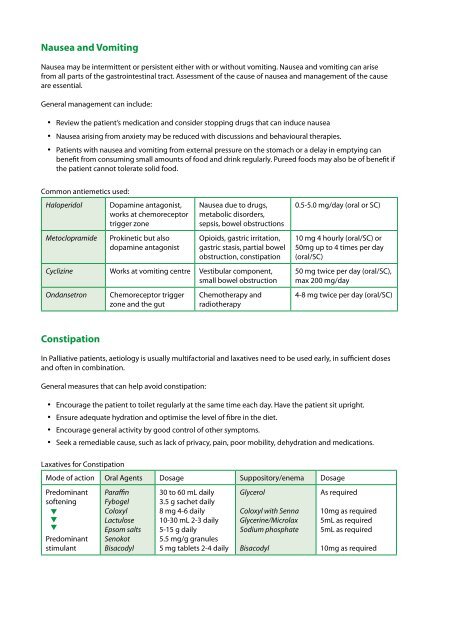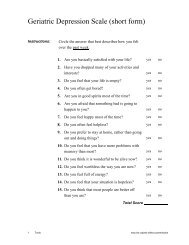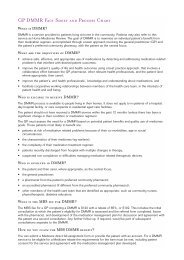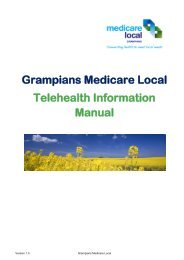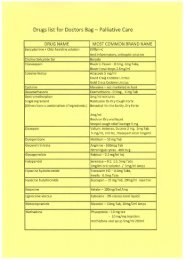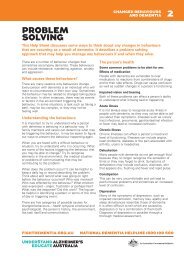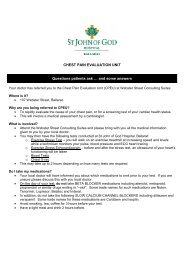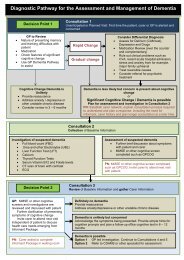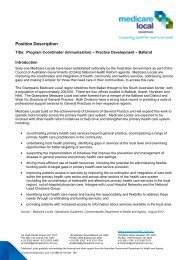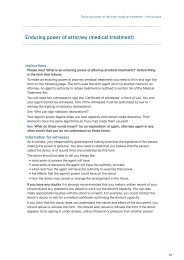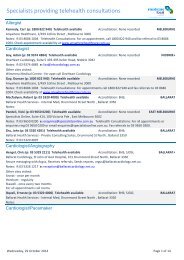Doctor's Bag: Palliative Care Information booklet - Grampians ...
Doctor's Bag: Palliative Care Information booklet - Grampians ...
Doctor's Bag: Palliative Care Information booklet - Grampians ...
Create successful ePaper yourself
Turn your PDF publications into a flip-book with our unique Google optimized e-Paper software.
Nausea and Vomiting<br />
Nausea may be intermittent or persistent either with or without vomiting. Nausea and vomiting can arise<br />
from all parts of the gastrointestinal tract. Assessment of the cause of nausea and management of the cause<br />
are essential.<br />
General management can include:<br />
• Review the patient’s medication and consider stopping drugs that can induce nausea<br />
• Nausea arising from anxiety may be reduced with discussions and behavioural therapies.<br />
• Patients with nausea and vomiting from external pressure on the stomach or a delay in emptying can<br />
benefit from consuming small amounts of food and drink regularly. Pureed foods may also be of benefit if<br />
the patient cannot tolerate solid food.<br />
Common antiemetics used:<br />
Haloperidol<br />
Metoclopramide<br />
Dopamine antagonist,<br />
works at chemoreceptor<br />
trigger zone<br />
Prokinetic but also<br />
dopamine antagonist<br />
Nausea due to drugs,<br />
metabolic disorders,<br />
sepsis, bowel obstructions<br />
Opioids, gastric irritation,<br />
gastric stasis, partial bowel<br />
obstruction, constipation<br />
Cyclizine Works at vomiting centre Vestibular component,<br />
small bowel obstruction<br />
Ondansetron<br />
Chemoreceptor trigger<br />
zone and the gut<br />
Chemotherapy and<br />
radiotherapy<br />
0.5-5.0 mg/day (oral or SC)<br />
10 mg 4 hourly (oral/SC) or<br />
50mg up to 4 times per day<br />
(oral/SC)<br />
50 mg twice per day (oral/SC),<br />
max 200 mg/day<br />
4-8 mg twice per day (oral/SC)<br />
Constipation<br />
In <strong>Palliative</strong> patients, aetiology is usually multifactorial and laxatives need to be used early, in sufficient doses<br />
and often in combination.<br />
General measures that can help avoid constipation:<br />
• Encourage the patient to toilet regularly at the same time each day. Have the patient sit upright.<br />
• Ensure adequate hydration and optimise the level of fibre in the diet.<br />
• Encourage general activity by good control of other symptoms.<br />
• Seek a remediable cause, such as lack of privacy, pain, poor mobility, dehydration and medications.<br />
Laxatives for Constipation<br />
Mode of action Oral Agents Dosage Suppository/enema Dosage<br />
Predominant<br />
Glycerol<br />
As required<br />
softening<br />
Predominant<br />
stimulant<br />
Paraffin<br />
Fybogel<br />
Coloxyl<br />
Lactulose<br />
Epsom salts<br />
Senokot<br />
Bisacodyl<br />
30 to 60 mL daily<br />
3.5 g sachet daily<br />
8 mg 4-6 daily<br />
10-30 mL 2-3 daily<br />
5-15 g daily<br />
5.5 mg/g granules<br />
5 mg tablets 2-4 daily<br />
Coloxyl with Senna<br />
Glycerine/Microlax<br />
Sodium phosphate<br />
Bisacodyl<br />
10mg as required<br />
5mL as required<br />
5mL as required<br />
10mg as required


